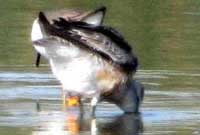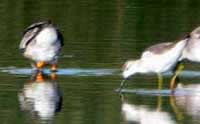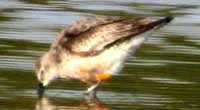Two individuals appeared in the Duck Pond. Yayoi focused the telescope and discovered the rings in one of them. They were very far but we managed to take some photos which show some of the rings fairly clearly.
 © Yayoi Sato-Germán Pugnali
© Yayoi Sato-Germán PugnaliThe pattern of the rings is as follows:
* Left leg: above the articulation: orange flag.
* Right leg: above the articulation: metal ring.
Up to here we are completely sure of what we saw.
What folows is probably more interesting but not 100% sure:
* Right leg, below the articulation: two plastic rings: red top, yellow bottom.
In the only photo showing this info colours are not clear, but we managed to see them with some difficulty when the bir raised the leg (and it was far).
We are positive sure of the yellow ring, and 90% of the red one.
 © Yayoi Sato-Germán Pugnali
© Yayoi Sato-Germán PugnaliThe orange flag means an individual was ringed in Argentina (there is one flag representing each country).
The metallic ring, whose number was unreadable from this distance, identifies the individual in case it is recaptured.
The other two rings are used by the investigator to set combinations and in this way for instance indicate the year the bird was ringed.
I put in touch with investigators who had been ringing this species. Patricia Gonzalez saw the photos and confirmed that this bird had been ringed in Rio Grande (TDF) in December 2000.
It must be arriving from the north (this species breed in the Arctic) and it is in its basic plumgae (only some reddishing colouring on the flank).
It may be go on travelling far south and is using the reserve to make a stop along the migration route.
 © Yayoi Sato-Germán Pugnali
© Yayoi Sato-Germán PugnaliFundación Vida Silvestre Argentina / Fundación Inalafquen has been ringing a great deal of birds in the last years.
If anyone happens to find a ringed bird, it would be useful to pay attention to this:
* Colour and data of the flay (some have letters and numbres which can be seen through a telescope).
* Colour, location and combination of the other coloured rings (the leg they are on and the order).
German Pugnali.
24-09-2006

